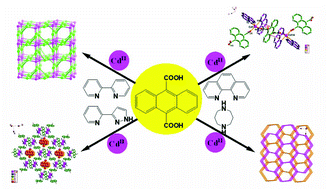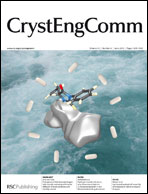In our efforts to continuously explore the influence of ligands with larger conjugated π-systems on the related structures and properties of their complexes, four CdII complexes with anthracene-9,10-dicarboxylate (L) and relevant auxiliary ligands were synthesized and characterized: {[Cd2(L)2(bipy)(H2O)2](C2H5OH)0.5(H2O)2.25}∞ (1), Cd2(L)(HL)2(phen)4 (2), {[Cd2(L)1.5(Hpypz)4](L)0.5}∞ (3), and {[Cd(L)2](H2daco)(C2H5OH)2(H2O)}∞ (4) (bipy = 2,2′-bipyridine, phen = 1,10-phenanthroline, Hpypz = 3-(2-pyridyl)pyrazole, and daco = 1,5-diazacyclooctane). Structural analyses show that complex 1 has a three-dimensional (3D) structure with a Schläfli symbol of (6·82)2(6·85). Complexes 2 and 3 take dinuclear and two-dimensional (2D) structures, respectively, due to the introduction of different 2,2′-bipyridyl-like chelating ligands, phen for 2 and Hpypz for 3. Complex 4 possesses another three-dimensional (3D) two-fold interpenetrating diamondoid network by introducing daco as an auxiliary co-ligand. The present results indicate that the natures of the auxiliary ligands have important effects on the formation of the final structures of such complexes. Moreover, the luminescent properties of complexes 1–4 and the corresponding ligands have also been investigated in detail.


 Please wait while we load your content...
Please wait while we load your content...